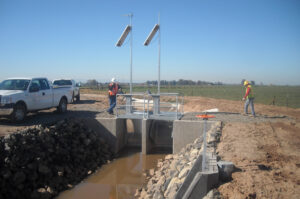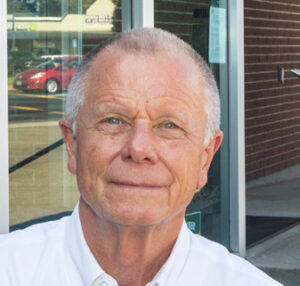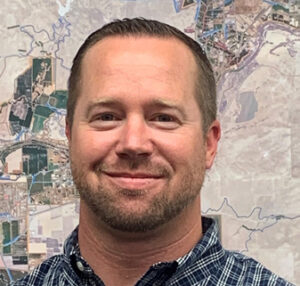Oakdale Irrigation District (OID) enjoys well-established water rights—from the Stanislaus River, deep wells, and water reclamation and drainage recovery systems—that allow it to provide abundant water to its growers even during times of drought. The district’s 2007 water resources plan mapped out a strategy for selling surplus water and investing the money into modernization and system rehabilitation, leading to more surplus. That cycle has generated about $75 million for the district and improved customer service, water reliability, and drought resiliency. In this interview, OID’s recently retired General Manager Steve Knell and Water Operations Manager and District Engineer Eric Thorburn tell us more.
Irrigation Leader: Please tell us about your backgrounds and how you came to be in your current positions.
Steve Knell: I am a graduate of the California Polytechnic State University, San Luis Obispo, with a degree in ag engineering. I did internships during college and eventually went to work for the U.S. Department of Agriculture Soil Conservation Service in Madera, where I spent 6 years as a field office engineer, servicing various field offices in the Central Valley. Later, I was transferred to El Centro, California, as an irrigation and salinity management team leader, working to address Salton Sea issues and state concerns on water use in the Imperial Valley. We helped the farmers of Imperial Irrigation District (IID) evaluate their irrigation systems, manage their water, and manage irrigation as it relates to salinity control. I liked the work so much that I eventually moved over to IID and worked there for 16 years. I eventually left IID and took a job as the general manager of OID. I’ve been here for 20 years, servicing the district, developing the water resources plan, and advancing the irrigation systems here by implementing technology with Rubicon systems.
Eric Thorburn: Upon graduating from the University of California, Davis (UC Davis), in 2006 with a bachelor’s degree in civil engineering, I went to work as a civil engineer at a local engineering firm, designing utilities, street improvements, and grading plans to accommodate residential and commercial development. I grew up around agriculture in the Central Valley of California, so when the financial crisis and economic downturn occurred in 2008, I had the chance to return to my roots in agriculture as an engineer at OID. After the design and construction of OID’s Total Channel Control (TCC) pilot project was completed in 2011, I jumped at the opportunity to move over to the water department as the water operations manager to assist in the operational integration process. I’m approaching 15 years at OID. My current role is water operations manager and district engineer.
Irrigation Leader: Please tell us about OID’s history and current services.

Steve Knell: OID and South San Joaquin Irrigation District (SSJID), which is to our north, were founded in 1909 under the Wright Act, which eventually evolved into the California Water Code. OID and SSJID are senior water right diverters on the Stanislaus River and share an equal stake in both water and developed infrastructure on the river. Our water right is 1,816.6 cubic feet per second of direct diversion off the river.
Early on, the district began the construction of Melones Dam in the Stanislaus basin, which was completed in 1926. Most streams in the Central Valley dried up in the summer, so storage was important to ensure irrigation supplies lasted into the fall. During the mid–20th century, the district developed the Tri-Dam projects, a series of dams in the Sierras that included Tulloch, Beardsley, and Donnells Dams. These dams all included hydroelectric units that the Pacific Gas and Electric Company (PG&E) cooperated with the districts to build and finance. Under the contract, PG&E would get the electricity from those facilities for a 50‑year period and in turn pay off the debt that was incurred to build them. The Tri-Dam facilities added almost 300,000 acre-feet of storage to the district.
In the 1970s, the Bureau of Reclamation looked at building a facility on the Stanislaus River as part of the federal Central Valley Project. New Melones Dam ended up being the last dam built under that project. New Melones Dam is a 2.4-million-acre-foot facility just upstream of OID’s Lake Tulloch Reservoir. To maximize hydro potential for the federal government, the districts and Reclamation agreed to use Tulloch Dam as an afterbay downstream of New Melones so they could install a hydro facility as part of the construction of New Melones. Under an operation agreement, Reclamation and the two districts converted the usable storage that was lost by the districts at Tulloch into storage behind New Melones. The districts also agreed with Reclamation, as part of their senior water right position on the river, to an entitlement to the first 600,000 acre-feet of runoff each year. That amount is split equally between OID and SSJID. The basin has about 1.1 million acre-feet of runoff on an annual basis. We’ve been acting under that agreement with Reclamation since 1986. It has afforded the district a stable, reliable water supply for its growers, even in these recent historical droughts.
Irrigation Leader: How big is your district, and what are the main crops grown in it?
Eric Thorburn: OID’s service area is approximately 82,000 acres, within which about 65,000 acres are actively irrigated. The main crops grown in the district are almonds; walnuts; and forage crops, consisting primarily of pasture and corn.
Irrigation Leader: Does OID still produce power?
Steve Knell: OID is a wholesale power seller. We have a 120‑megawatt generating capacity. All that energy is sold under contract to a buyer. For 50 years, it was PG&E, but now Santa Clara Valley Power is our sole electricity customer. It buys it at a fixed rate, and we share those payments 50/50 with SSJID.
Irrigation Leader: Please describe your canals and delivery infrastructure and the modernization you’ve done with Rubicon Water’s technology.
Eric Thorburn: OID operates and maintains a total of about 200 miles of open ditch and 100 miles of pipeline. We also have two regulating reservoirs, strategically located approximately one-third of the way down on the north and south sides of our system, which is about 18 hours’ water travel time from the river diversion. Most inline drop structures above the regulating reservoirs are long-crested weirs that ensure that consistent upstream levels are maintained for the delivery points and lateral headings in those upper pools. We generally manage our regulating reservoirs within the middle third of their available storage volume to allow room to immediately store or supply already-stored water during unexpected demand fluctuations upstream and downstream.
Early on, following the adoption of our water resources plan, we also began automating our lateral headings. Typically, we’d install a FlumeGate, which is Rubicon’s automated overshot gate, in drop structures that were next to another OID lateral heading to maintain the water level in the upstream pool. The adjacent lower-capacity lateral heading was then also automated with either another FlumeGate or a SlipMeter, which is Rubicon’s automated undershot gate, to maintain a desired flow rate down that lateral. Both automated gates provided real-time and historic flow measurement readings to the operator’s desktop or tablet over our SCADA system. Our operators were then able to monitor and manage these areas of the system remotely. The consistent upstream water level ensured a steady flow rate through all the offtakes in that pool, which resulted in significant improvements in efficiency and levels of service while also decreasing operational spill from the end of our system.
In 2010, after Rubicon approached OID with some new developments in its hardware and software, we were able to take it one step further with a pilot project. Rubicon’s new TCC technology allowed these automated gates to use water level and flow data from the pool immediately downstream to automatically adjust to maintain the water level in the downstream pool. In other words, rather than operate in upstream level control, they would operate in downstream level control. A total of 15 miles of OID’s open ditch system was automated as part of the TCC pilot project. Rubicon FlumeGates were installed in each of the new or retrofit inline drop structures in place of our old wooden drop-board weirs. After system integration, water levels in each pool were consistently maintained within 2 inches of the set point, and operational spill from the end of the automated laterals was nearly eliminated.
Given the success, we’ve been expanding our TCC system since that time and are now operating a total of almost 35 miles of completely automated laterals in downstream control. All our operators have tablets, and the district now has over 300 automated or remotely monitored SCADA sites, including the Rubicon system as well as level sensors and flow meters at various turnouts and boundary outflow sites.
Steve Knell: Before installing the TCC system, our district was on a rotation system in which water was moved through our infrastructure and then taken out. The ditch would then be dry until the next irrigation. With the TCC system, water is always in the canal. UC Davis conducted a study that showed that this results in increased infiltration into the aquifer, helping recharge the aquifer and benefiting the district.
Irrigation Leader: Why did the district conclude that developing a water resources plan was necessary, and how was it implemented?
Steve Knell: We had 100‑year-old infrastructure in place that had never been improved or invested in. We knew that if we were going to replace it, we wanted to incorporate modern technology. We chose Rubicon as that technology. The plan also envisioned that these improvements would conserve water that could be sold, creating a revenue stream so that we could keep water rates affordable for the landowners in the district. Of all the revenue generated under our water resources plan, 80 percent went to capital improvements and 20 percent went to operational expenses. The implementation of the water resources plan has generated about $75 million for the district. That investment went back into modernization projects that have advanced the district. Without that, we would have had to raise water rates for our growers.
Irrigation Leader: How has the district engaged with its irrigation customers to encourage modernization and water efficiency?
Steve Knell: Our farmers used to be on rotational deliveries and were required to irrigate on regular cycles, but with our TCC system, farmers can irrigate on a flexible schedule. Now, a farmer can give the water back when he’s done, and the district moves it to a reservoir rather than spilling it. Twenty years ago, we were using 255,000–260,000 acre-feet a year. Today, it’s down to 225,000–230,000 acre-feet on a regular basis. We’ve also added 10,000 acres of agricultural land to our district through annexations, because we have the water to serve them. The flexible and reliable supply allows farmers to shift to higher-value crops. Almonds are now the biggest crop in an area that used to be primarily pasture.
Eric Thorburn: We consult with and assist growers who are high water consumers to improve their irrigation practices. We routinely run reports to identify high water use and monitor in the field for excessive runoff, leaky pipelines, and similar things. We also keep a contact list of local irrigation design companies, contractors, and the Natural Resources Conservation Service as a resource for growers who want to make improvements or repairs on farm or on private irrigation facilities.
Irrigation Leader: What is your vision for the future?
Eric Thorburn: We’re going to continue to automate, to become more efficient, to drive water savings, and to become more drought resilient by reducing diversions and improving operational efficiency. We are in an interesting predicament in this groundwater basin after the passage of the Sustainable Groundwater Management Act in 2014. Our groundwater sustainability plans show that while OID is sustainable, there are areas east of us that rely solely on groundwater and are not operating sustainably. We want to drive water savings and reach sustainability, hopefully along with those areas. We want to put our water savings to use, ideally locally, by selling them at a price that makes sense for those areas and thereby generating the funding we need for continued capital improvements and modernization. That’s the plan: more modernization and automation and a continued improvement of the operational efficiency, drought resiliency, and service we offer to our growers funded by the sale of the water we conserve.
Steve Knell: We’re now in the second year of one of the deepest droughts we’ve had, and unfortunately, they’re anticipating a third year. The last 20 years have been the driest in the last 1,200 years. We don’t see that changing. You have to believe that water is going to get more precious in this state, and we are all going to be asked to chip in and focus on how best to conserve water in our districts. Agriculture controls most of the water, so there’s going to be a lot of pressure on agriculture to step up, to begin investing in modernization and technologies that can conserve water, and to make that water available. We believe in marketing that water. If a district is going to invest money in technology and automation, it should be compensated for the investment. That paradigm has worked for OID.
Steve Knell recently retired as the general manager of Oakdale Irrigation District.

Eric Thorburn is the district engineer and water operations manager of Oakdale Irrigation District. He can be contacted at ethorburn@oakdaleirrigation.com.

